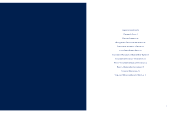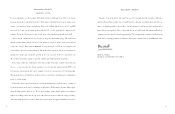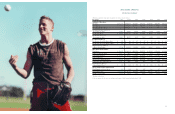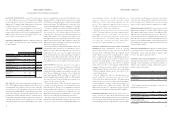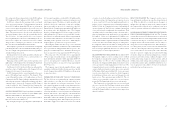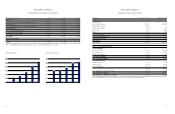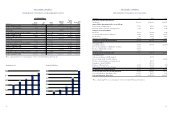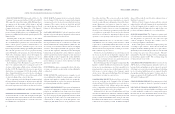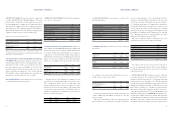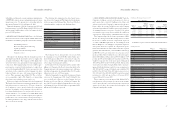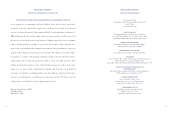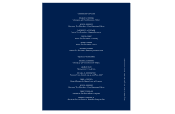Abercrombie & Fitch 1999 Annual Report Download - page 14
Download and view the complete annual report
Please find page 14 of the 1999 Abercrombie & Fitch annual report below. You can navigate through the pages in the report by either clicking on the pages listed below, or by using the keyword search tool below to find specific information within the annual report.
23
Abercrombie &Fitch Co.
22
1. BASIS OF PRESENTATION Abercrombie & Fitch Co. (the
“Company”) was incorporated on June 26, 1996, and on July 15,
1996 acquired the stock of Abercrombie & Fitch Holdings, the par-
ent company of the Abercrombie & Fitch business, and A&F
Trademark, Inc., in exchange for 43 million shares of Class B
Common Stock issued to The Limited, Inc. (“The Limited”).
The Company is a specialty retailer of high quality, casual apparel
for men, women and kids with an active, youthful lifestyle. The
business was established in 1892 and subsequently acquired by The
Limited in 1988.
An initial public offering (the “Offering”) of 16.1 million
shares of the Company’s Class A Common Stock, including the
sale of 2.1 million shares pursuant to the exercise by the under-
writers of their options to purchase additional shares, was
consummated on October 1, 1996. The net proceeds received
by the Company from the Offering, approximating $118.2 million,
and cash from operations were used to repay the borrowings
under a $150 million credit agreement. As a result of the Offering,
84.2% of the outstanding common stock of the Company was
owned by The Limited, until the completion of a tax-free
exchange offer (the “Exchange Offer”) on May 19, 1998, to estab-
lish the Company as an independent company.
In the Exchange Offer, The Limited accepted 94,150,104
shares of its common stock that were exchanged at a ratio of .86
of a share of Abercrombie & Fitch stock for each Limited share.
On June 1, 1998, The Limited effected a pro rata spin-off to its
shareholders of its remaining 6,230,910 Abercrombie & Fitch
shares. Limited shareholders of record at the close of trading on
May 29, 1998 received .027346 of a share of Abercrombie & Fitch
stock for each Limited share owned at that time.
The accompanying consolidated financial statements include
the historical financial statements of, and transactions applicable
to the Company and its subsidiaries and reflect the assets, liabil-
ities, results of operations and cash flows on a historical cost basis.
2. SUMMARY OF SIGNIFICANT ACCOUNTING POLICIES
PRINCIPLES OF CONSOLIDATION The consolidated financial
statements include the accounts of the Company and all signif-
icant subsidiaries that are more than 50% owned and controlled.
All significant intercompany balances and transactions have
been eliminated in consolidation.
FISCAL YEAR The Company’s fiscal year ends on the Saturday
closest to January 31. Fiscal years are designated in the financial
statements and notes by the calendar year in which the fiscal year
commences. The results for fiscal years 1999, 1998 and 1997
represent the fifty-two week periods ended January 29, 2000,
January 30, 1999 and January 31, 1998.
CASH AND EQUIVALENTS Cash and equivalents include
amounts on deposit with financial institutions and investments
with original maturities of less than 90 days.
MARKETABLE SECURITIES All investments with original matu-
rities of greater than 90 days are accounted for in accordance with
Statement of Financial Accounting Standards (“SFAS”) No. 115,
“Accounting for Certain Investments in Debt and Equity
Securities.” The Company determines the appropriate classifi-
cation at the time of purchase. At January 29, 2000, the Company
held investments in marketable securities which were classified
as held to maturity based on the Company’s positive intent and
ability to hold the securities to maturity. All securities held by the
Company at January 29, 2000 are corporate debt securities which
mature within one year and are stated at amortized cost which
approximates market value.
INVENTORIES Inventories are principally valued at the lower
of average cost or market, on a first-in first-out basis, utilizing the
retail method.
STORE SUPPLIES The initial inventory of supplies for new
stores including, but not limited to, hangers, signage, security tags
and point-of-sale supplies are capitalized at the store opening date.
Subsequent shipments are expensed except for new merchandise
presentation programs which are capitalized.
PROPERTY AND EQUIPMENT Depreciation and amortization
of property and equipment are computed for financial reporting
purposes on a straight-line basis, using service lives ranging
principally from 10-15 years for leasehold improvements and 3-
10 years for other property and equipment. Beneficial leaseholds
represent the present value of the excess of fair market rent over
contractual rent of existing stores at the 1988 purchase of the
Company by The Limited and are being amortized over the
NOTES TO CONSOLIDATED FINANCIAL STATEMENTS
Abercrombie &Fitch Co.
lives of the related leases. The cost of assets sold or retired and the
related accumulated depreciation or amortization are removed
from the accounts with any resulting gain or loss included in net
income. Maintenance and repairs are charged to expense as
incurred. Major renewals and betterments that extend service lives
are capitalized. Long-lived assets are reviewed for impairment
whenever events or changes in circumstances indicate that full
recoverability is questionable. Factors used in the valuation
include, but are not limited to, management’s plans for future
operations, recent operating results and projected cash flows.
INCOME TAXES Income taxes are calculated in accordance
with SFAS No. 109, “Accounting for Income Taxes,” which
requires the use of the liability method. Deferred tax assets and
liabilities are recognized based on the difference between the
financial statement carrying amounts of existing assets and lia-
bilities and their respective tax bases.
Deferred tax assets and liabilities are measured using enacted
tax rates in effect in the years in which those temporary differ-
ences are expected to reverse. Under SFAS No. 109, the effect on
deferred taxes of a change in tax rates is recognized in income in
the period that includes the enactment date.
Prior to the Exchange Offer, the Company was included in The
Limited’s consolidated federal and certain state income tax groups
for income tax reporting purposes and was responsible for its
proportionate share of income taxes calculated upon its federal tax-
able income at a current estimate of the Company’s annual
effective tax rate. Subsequent to the Exchange Offer, the Company
began filing its tax returns on a separate basis.
SHAREHOLDERS’ EQUITY The Board of Directors declared a
two-for-one stock split on the Company’s Class A Common
Stock, paid June 15, 1999 to shareholders of record at the close
of business on May 25, 1999. All share and per share amounts
in the accompanying consolidated financial statements for all
periods have been restated to reflect the stock split.
At January 29, 2000, there were 150 million shares of $.01 par
value Class A Common Stock authorized, of which 102.0 million
and 102.8 million shares were outstanding at January 29, 2000 and
January 30, 1999 and 106.4 million shares of $.01 par value Class
B Common Stock authorized, none of which were outstanding
at January 29, 2000 or January 30, 1999. In addition, 15 million
shares of $.01 par value Preferred Stock were authorized, none of
which have been issued.
Holders of Class A Common Stock generally have identical
rights to holders of Class B Common Stock, except that holders
of Class A Common Stock are entitled to one vote per share
while holders of Class B Common Stock are entitled to three votes
per share on all matters submitted to a vote of shareholders.
REVENUE RECOGNITION The Company recognizes retail
sales at the time the customer takes possession of the merchan-
dise and purchases are paid for via cash, credit card or gift
certificate redemption. Catalogue and e-commerce sales are
recorded upon shipment of merchandise.
In the fourth quarter of 1999, the Company changed its
accounting for gift certificates. Under the new method, the
Company establishes a liability upon the sale of a gift certificate.
The liability is reduced when the gift certificate is redeemed and
the customer takes possession of the merchandise. The infor-
mation in Note 14 provides the impact of the accounting change
for the first three quarters of 1999. The accounting change was
not material to prior year results.
CATALOGUE AND ADVERTISING COSTS Costs related to the
A&F Quarterly, a catalogue/magazine, primarily consist of cata-
logue production and mailing costs and are expensed as incurred.
Advertising costs consist of in-store photographs and advertising
in selected national publications and are expensed when the
photographs or publications first appear. Catalogue and adver-
tising costs amounted to $30.3 million in 1999, $24.9 million in
1998 and $13.7 million in 1997.
STORE PREOPENING EXPENSES Preopening expenses related
to new store openings are charged to operations as incurred.
FAIR VALUE OF FINANCIAL INSTRUMENTS The recorded
values of current assets and current liabilities, including accounts
receivable, marketable securities and accounts payable, approx-
imate fair value due to the short maturity and because the average
interest rate approximates current market origination rates.


